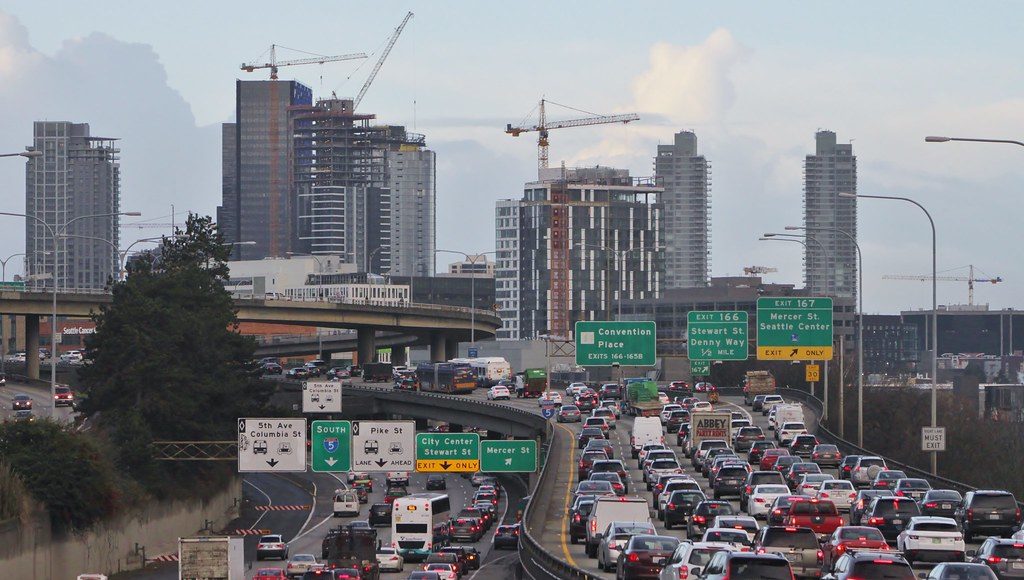
With all the proposals being aimed at our crumbling, over-tasked, city-busting Interstate 5, as I explored in an earlier post, there is an obvious question to ask. Who is planning the future, for 20 years, let alone 50, for the role I-5 will play in meeting our transportation needs?
Answer: Nobody. Startling, but true.
Former Governor Christine Gregoire in 2015 joined regional business leaders in the big roll-out of Challenge Seattle, including I-5 in a proposed transportation vision for 2035. If a glossy website and euphonious verbiage promised a real action plan, we would have seen some specifics by now. But on I-5 futures, Challenge Seattle has basically disappeared without a trace.
Puget Sound Regional Council, our regional planning agency, in 2017 raised with Washington State Department of Transportation (WSDOT) the need for WSDOT’s developing a long-range vision for the I-5 corridor. WSDOT responded with the usual litany of I-5 vexations: crumbling facility, seismic vulnerability, slow and unreliable traffic performance, freight bottlenecks, and more. Steps to start with: outreach to opinion leaders; framework for local involvement; staffing up -– the usual feints that hope to be mistaken for action. Actual substantive suggestion? Manage the HOV lanes better. We’ve known that for years.
WSDOT moved on. Inviting almost everyone in sight to come together on bottom-up consensus solutions. Enlisting 14 cities (Lakewood to Lake Stevens), three counties, three ports, four transit agencies, and a stakeholder round-up of 22 of the usual suspects, from the Nature Conservancy to the Master Builders Association. After meeting a dozen times, there emerged the best-yet documented catalog of I-5’s needs. However, as groups like this, or their ghostwriters, will so often end up, the outcome report admired the complexity of the problem in a glossy Call to Action. But no proposed future solutions.
Meanwhile, recognizing that at some point at least a token level of actual work would have to grapple with an I-5 future, last year saw a state budget request for $2.5 million in planning funds for the 117-mile I-5 corridor including through Seattle. Not much, but at least a token put down on the need to move ahead. The Senate Transportation Committee signed on, but the House Transportation Committee (Jake Fey, D-Tacoma, is the committee chair) would not squeeze that small ask into a $9.9 billion biennial WSDOT budget.
If that seems startlingly, bizarrely myopic, it’s worth remembering that the City of Seattle’s nine-year $930-million Move Seattle transportation levy taken to voters in 2015 didn’t even mention I-5’s Seattle street-level ramifications in its spending visions.
Today not one dollar or one hour at either WSDOT or SDOT is being spent (officially) on large-scale, large-vision planning for the future I-5 transportation function into and through Seattle. Maybe it would help if we bestowed on the problem the perfect cliché: the 800 pound gorilla of our city’s and state’s transportation mess. Governor Jay Inslee should think it’s a priority, but of that you will get no inkling from his transportation tout sheet. Nor would you find anything about the I-5 future in Mayor Jenny Durkan’s transportation priorities.
Can a flicker of hope be found anywhere? Last July, for the first time I can find, a proposal emerged that takes the necessary step of putting the full two-piece problem on one page. This was achieved when WSDOT and the City of Seattle threw a $4.2 million Partnering for the Future of I-5 grant request into the vast hopper of the U.S. Department of Transportation’s Build Transportation Discretionary Grant Program. Two pieces are in the proposal. Start work on a long-range transportation master plan for I-5. And plan for lidding I-5 segments through downtown Seattle to leverage new development.
Great grant proposal. Just one fatal problem. WSDOT, the City of Seattle, and everyone else think the prospect of the Trump Administration’s funding this blue-state proposal for planning, which doesn’t even propose to build anything with the money, is exactly zero.
So there you have it. Plenty that needs to be done. Nothing happening. Nothing about to happen.
The feeling resembles crawling through Seattle in bumper-to-bumper traffic trying to get to SR 520. Or stuck southbound at Northgate on a Saturday morning. Or stacked back on Mercer on any commute afternoon. Or wondering why traffic on 80th NE heading for I-5 can be backed up from I-5 to Greenwood. These punishments fit the crime of neglect.
So, how will we find a way out? We won’t find a path forward until the governor of the state of Washington and the mayor of the City of Seattle decide it is in their urgent mutual and respective interests to work on this problem together. Not for today’s transportation system, or yesterday’s, but for the future.
Otherwise, we’re cooked, stuck in the molasses of an epic traffic jam.
Discover more from Post Alley
Subscribe to get the latest posts sent to your email.

This story illustrates a sad reality in Seattle politics, which is to overlook the big issues (cost, crime, congestion, affordability) and focus on small matters that mean a lot to micro-constituencies. Someone described these priorities as “an instinct for the capillaries.” The other problem in addressing transportation is the civil war between the four-wheelers and the two-wheelers, such that any politicians who dare to pay attention to crumbling and over-crowded highways will find themselves roadkill. Better to study, delay, blame. Big issues are big risk.